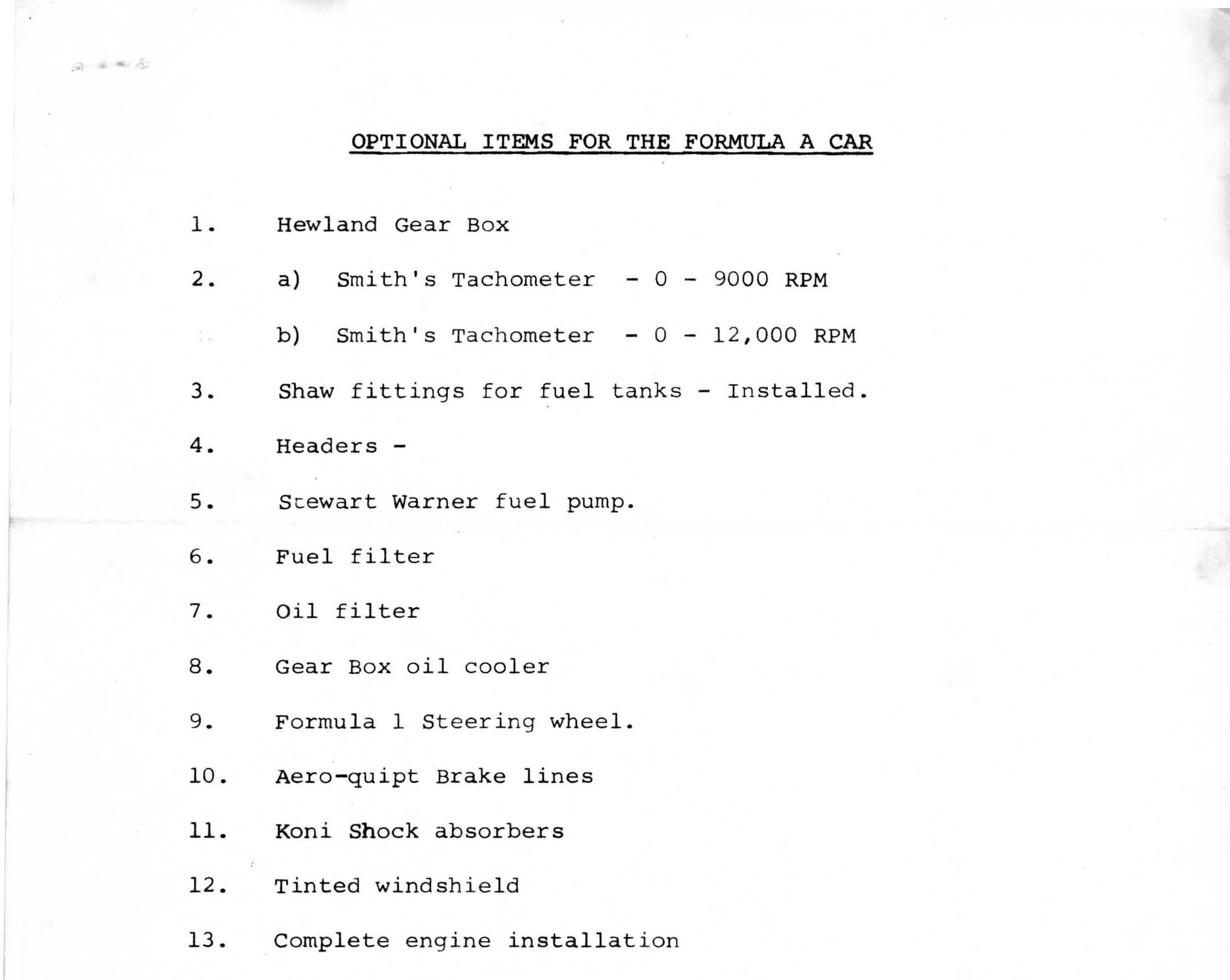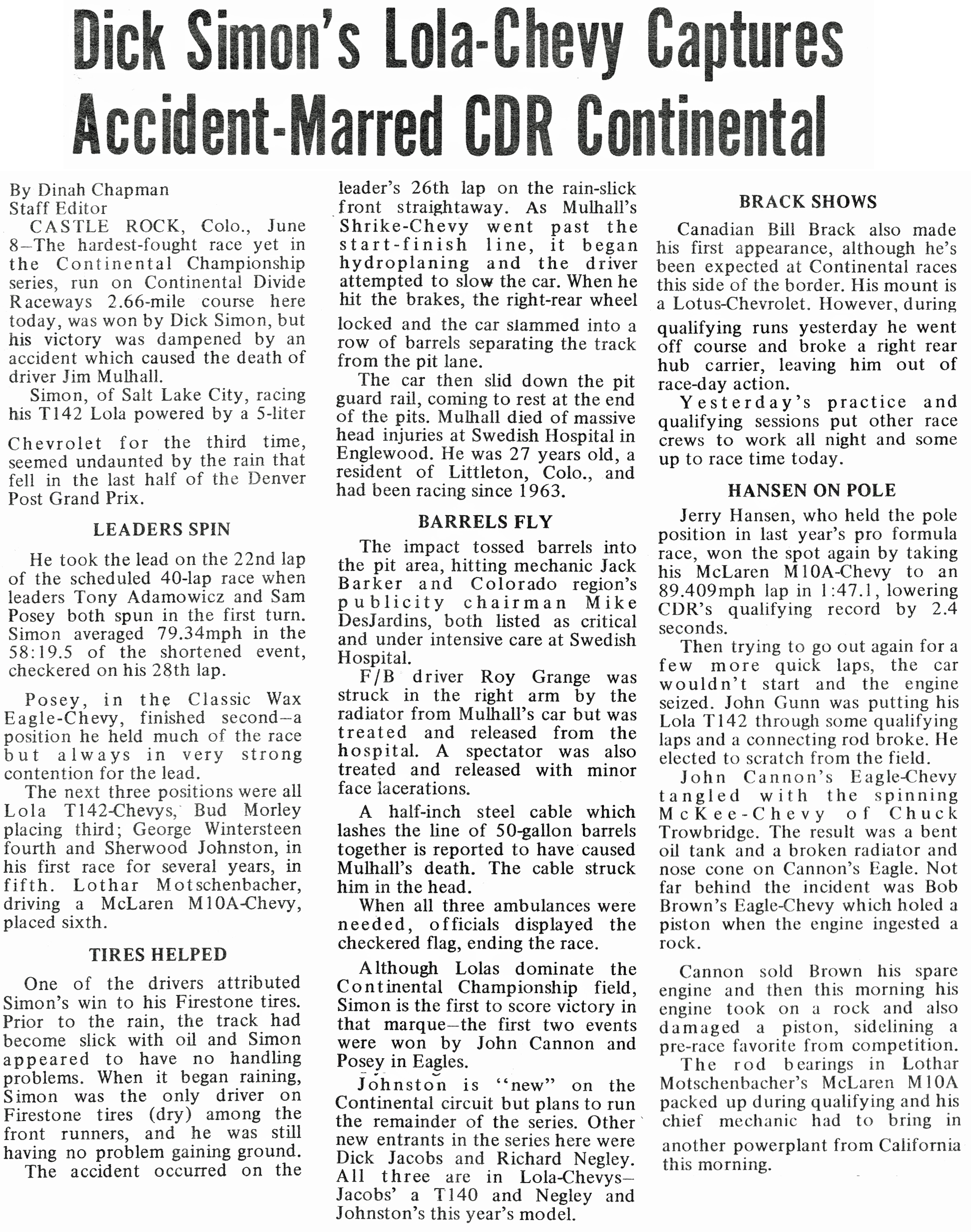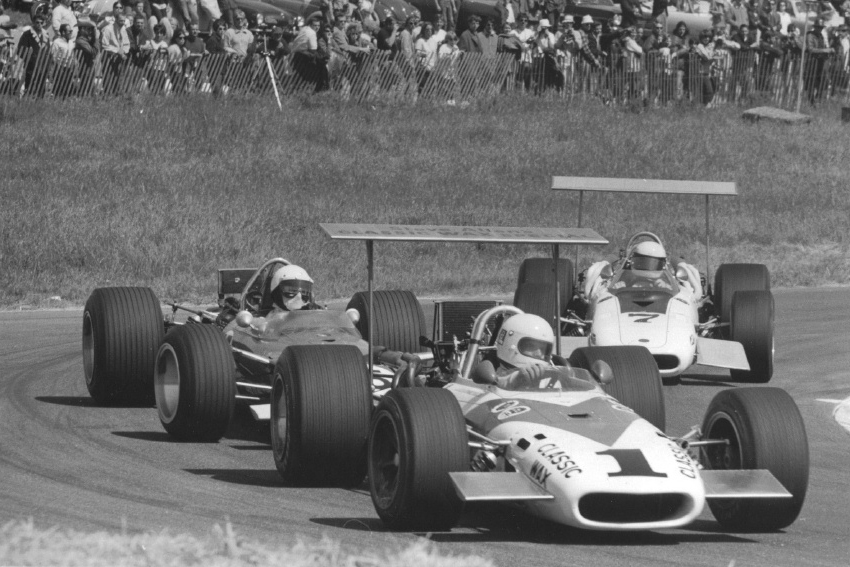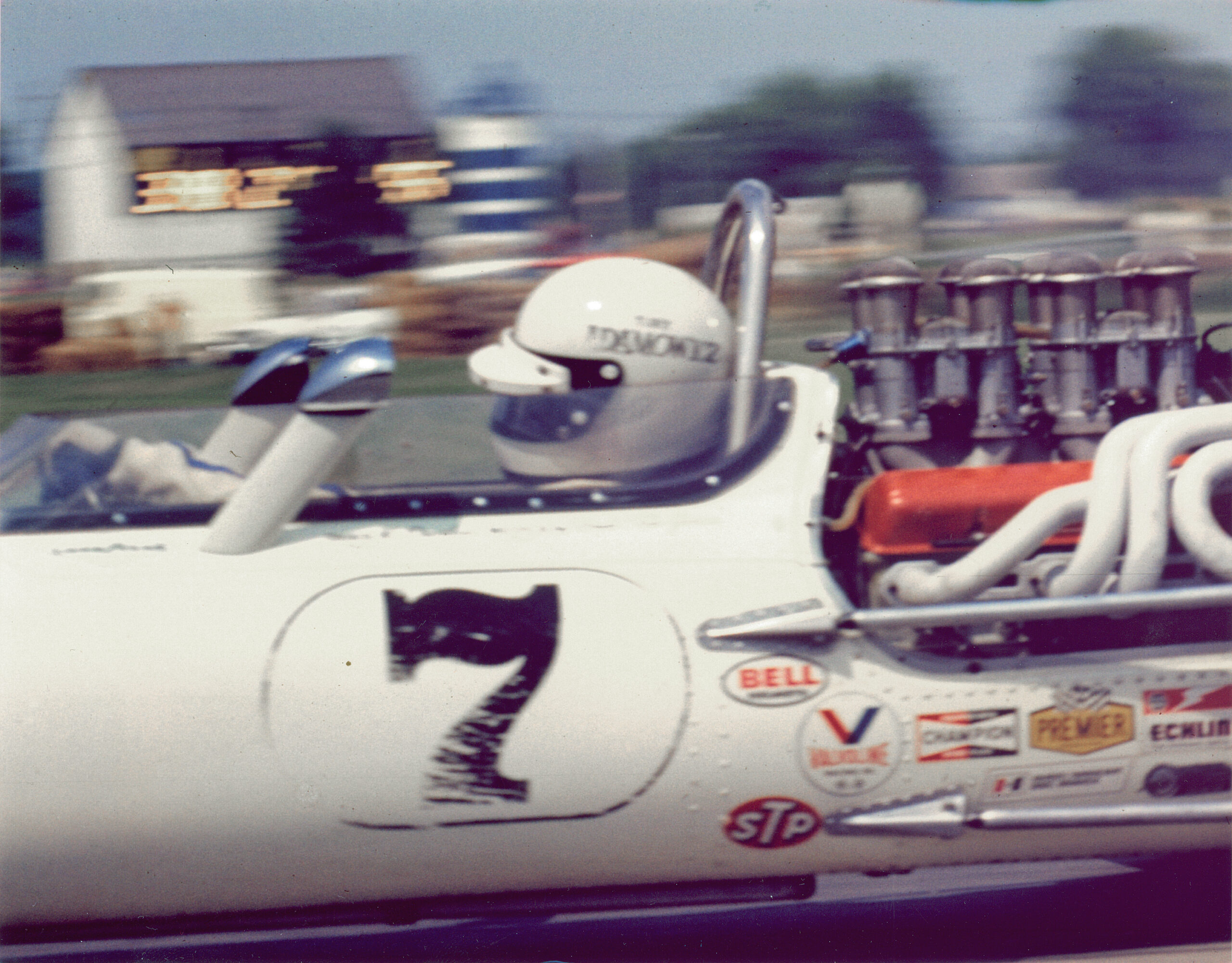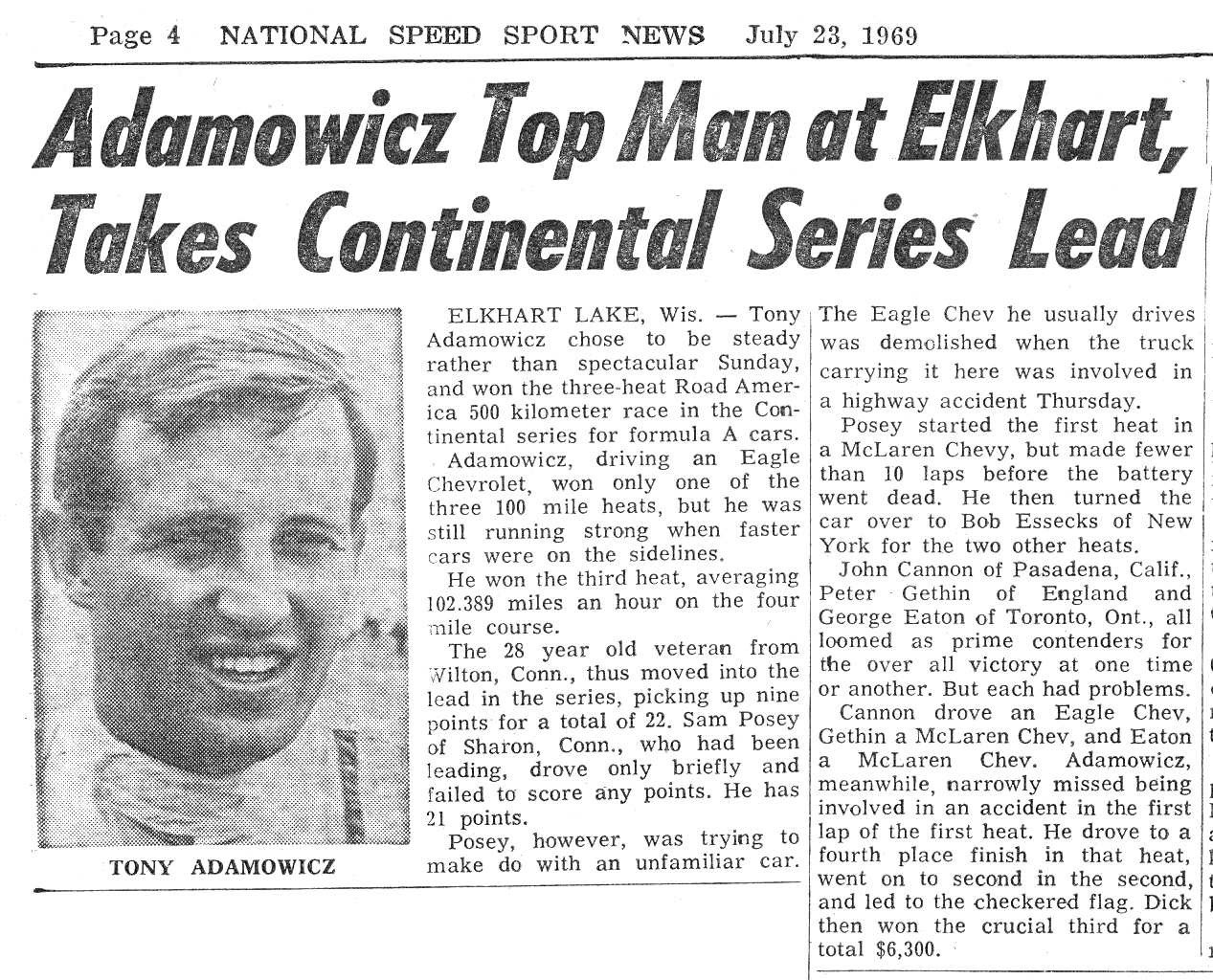1969 Milestone Racing – F5000
In 1969, Mac Tilton left Milestone Racing to work with BRE, Pete Brock’s Datsun team. Don Breslauer stayed partially into the year while we fielded an AAR Eagle Formula A/5000 to a championship. Milestone Racing became known as a proficient team to contend with. Carroll Smith had joined our team after the 3rd race of the season. On loan from Carroll Shelby at the time, he was very instrumental, along with Roy Wade, my former Group 44 roommate and mechanic, to provide me a winning Championship platform. It was the first time ever for me to drive a Formula car.
Adamowicz collection
I totaled our first Eagle (Chassis No. 502) at Willow Springs Raceway while early testing in April; the car became airborne in Turn 6 and catapulted into the air 30 feet, plummeted downward, breaking away the right front suspension and front brake caliper assembly within a stone’s throw away from the pit straight. The Eagle’s monocoque was wrinkled from front to rear absorbing the energy of the crash. I suffered a cut above my right eye and badly brushed ribs. With less than two weeks before the first race, our new Eagle was not completed, and I lost any further opportunity to get acquainted with an open wheel Formula A 5000 car.
These cars produced 465 to 500 hp and were more than a handful to maintain on the track. Our first Eagle did not have any aero down force, it was sans any front or rear wings. I would never drive the new Eagle without any front or rear wings; this is a much-needed assist to keep these cars glued to the track. The Eagle was a narrow track car with a short wheelbase, making it very nervous appearing on the track. I would have to learn how to drive the car smoothly if I wanted to survive. I also made a decision to give up my open-faced helmet and be one of the first drivers to wear the full-face closed helmet made available by Bell Helmets. It would have protected me in the crash and certainly I find out protected my face, eyes from stones being thrown up from other cars with the wide rear tires.
The new chassis number 510 was finally completed at the AAR factory and we were able to install the Traco built engine and Hewland LG transaxle.
Public relation photo
Our Milestone Racing crew was green as well, not from mechanical preparation experience, but with open wheel racers. Master mechanic Roy Wade and Don Breslauer followed me from the Group 44 racing team that gave me a professional start in racing. It was now time for me to fit the driving position, pedal assembly, steering wheel and that is when I found out that I could not get into the cockpit by myself. With my bruised ribs, I had to be helped into the cockpit and soon found out in practice for the first time at Riverside, that the track surfaces were rough and transmitted every small impact to my bruised ribs.
One of the rudest awakenings was to have the feedback into the small steering wheel from the wide front tires; it wanted to whip the wheel out of your hands. The brakes were not there at the end of the straightaway as result of front spindle flex knocking back the pads in the caliper. One had to pump your brakes at the end of the straights to have a positive brake pedal; unbelievable that a real racing car had these characteristics. Being new to open wheel racing, I made an assessment that more could be done to improve these issues for future races. One of the first things we custom built and added to the Eagle’s steering rack was a Koni steering rack shock absorber from a Porsche 911 be installed. This helped considerably absorbing any of the nasty feed back into the steering wheel. The brake pedal issue was not resolved until we had AAR make up a Y pedal to allow me to utilize my left foot to pump up the brake pedal at the end of the straights. I eventually realized I could benefit from learning left foot brake techniques. This solidly provided me with a brake pedal at the end of the straights and allowed me to have a competitive edge, modulating the brake pedal into turns. I was the only “left foot braker” in the series. It was a relatively unknown technique in road racing. This would carry on into my many future racing car experiences.
Adamowicz collection – Koni Shocks photo
Winning crew at Lime Rock CT: crew chief: Roy Wade, manager/engineer: Carroll Smith, car owner, Marvin Davidson, and Tony a2z. Without Carroll Smith, I wouldn’t have won the Championship. He taught me a lot and was a good hands-on team manager. This photo became part of the STP calendar.
Invoice for AAR Chassis 502

Invoice for AAR Chassis 510
First page of Tony’s driver contract with Davidson Enterprises

Tony’s 1969 FIA license

Tony’s 1969 SCCA license
1968
Danville, Virginia
Initial Eagle testing
Select photographs of Tony’s first ride during testing at Virginia International Raceway in 1968.

Adamowicz collection – Barry Tenin photo
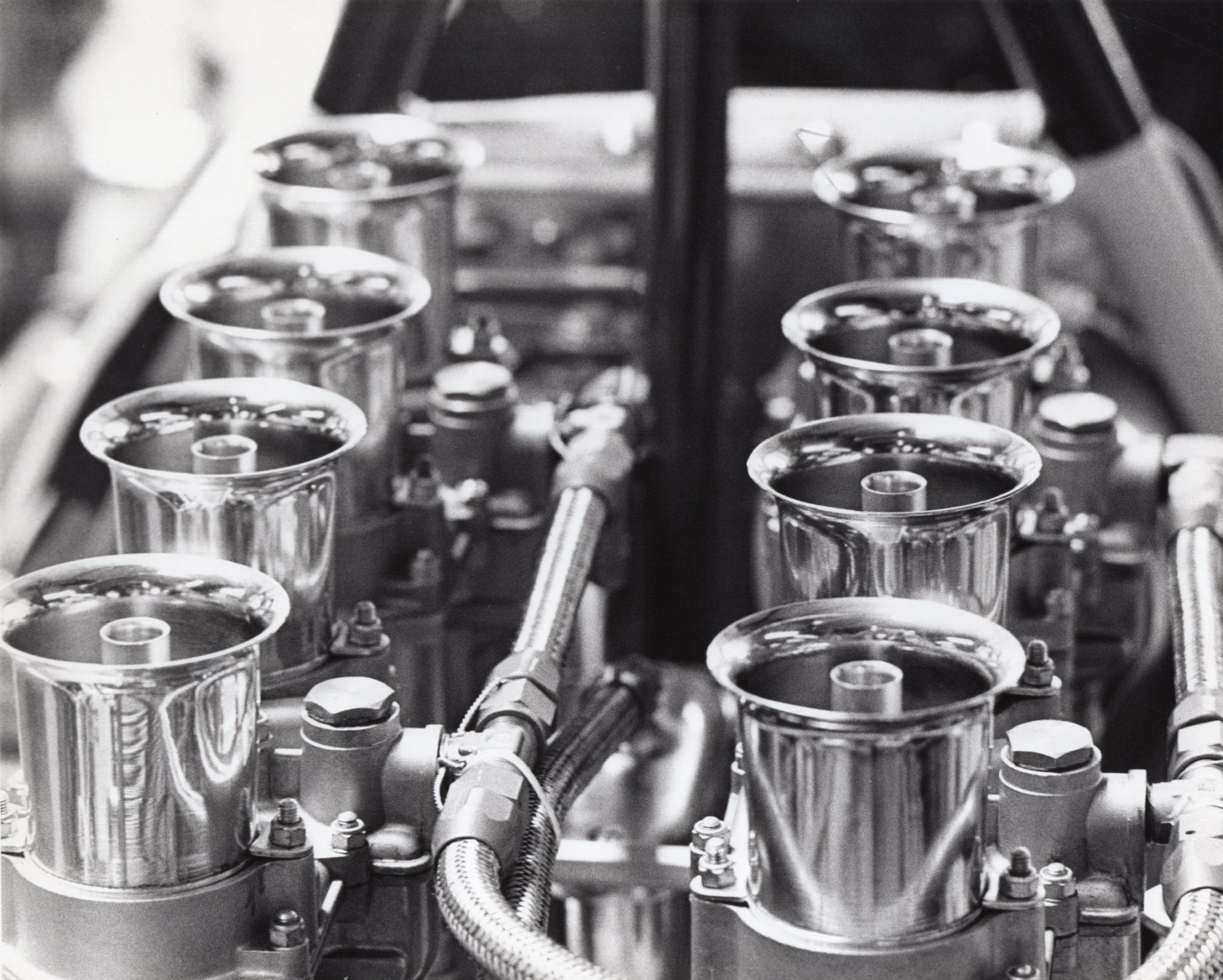
Adamowicz collection – Barry Tenin photo
The first time I entered into the Eagle at Virginia International Raceway for a Car & Driver magazine test, I knew I was over my head. No fenders, four open wheels, a narrow track, short wheelbase – a “go cart on steroids.” 1500 lbs of pure excitement. How do you master this machine capable of 190 plus mph and plenty of torque coming out of the turns to break loose at anytime?

Adamowicz collection – Barry Tenin photo

Adamowicz collection – Barry Tenin photo

Adamowicz collection – Bill Oursler photo

Adamowicz collection – Barry Tenin photo

Adamowicz collection – Barry Tenin photo
Jack Cowell, Car & Driver Racing 1969:
Before we crashed Sam Posey’s 427 cu. in. aluminum Chevrolet-powered Can-Am Lola T-160, we had planned to bring you some kind of comparison test between it and the Formula A Eagle-Chevy which Marvin Davidson bought for Tony Adamowicz to drive in the SCCA’s Continental Series.
We had decided that this would be about the surest way of bringing the open wheel formula to your attention and at the same time give you some sort of scale to measure the performance and magnitude of these cars. We wanted to be certain that you understood that this is a major formula and that these cars really fly and that they are going to put on some great racing.
But only moments after Adamowicz and his crew arrived at Virginia International Raceway-ending an all-night tow from Connecticut – Posey’s Lola shot off into the woods at 100 mph and self-destructed, leaving the Eagle, which was still sitting on the trailer, some new kind of comparison test winner.
Adamowicz was keen to run the Eagle anyway, so we watched while the fast-rising young sports car driver, who has impressed the racing fraternity with his handling of Lotus-Cortinas and 911 Porsches in SCCA Trans-Am sedan racing, took his first ever ride in a formula car.
Mechanics Roy Wade and Don Breslauer rolled the car off the trailer, cleaned, adjusted and primed it and at the appropriate moment Adamowicz appeared from behind the pickup in his Nomex White Knight suit and brushing off his shoes slid carefully around the black leather wheel into his contour-padded cockpit.
Adamowicz has been racing a year or two now and in a straight sort of way is very cool. But he was obviously excited as hell about getting out there in his new Eagle. This was to be exclusively his super-toy for the next few months. Adamowicz lay back there in comfort and for a while just switched his senses to ‘input’, the 302-inch Weber-carburetted Chevy splitting the air behind his head. The all-enclosed feeling, the naked front wheels standing tall ahead of him, the rear wheels just out of his peripheral vision. Finally, he snicked the car into first and rolled out of the pits onto this very challenging 3.1-mile road course. He had a little problem getting the non-synchro Hewland gears meshing smoothly at first, and after five slow laps pulled in.
“It’s like flying an aircraft,” he said smiling. “The cockpit is very comfortable, you feel as though the whole car is a part of you.” The front wheels didn’t bother him. “I thought they would at first,” he said, “but you don’t really spend any time looking at them. You know, you feel very safe. The brakes are perhaps as fantastic as anything about the car. They really haul you down to the extent of lifting you out of the seat against your harness.”
Adamowicz went back out and for the rest of the afternoon ran intermittently, not hurrying, although he spun cresting the right hander before the hairpin, but lapping at 2:20-odd – a full 12 seconds off the lap record. The afternoon turned into a routine race car testing session. Adamowicz had taken a step forward in his racing career.

Humphrey Sutton photo
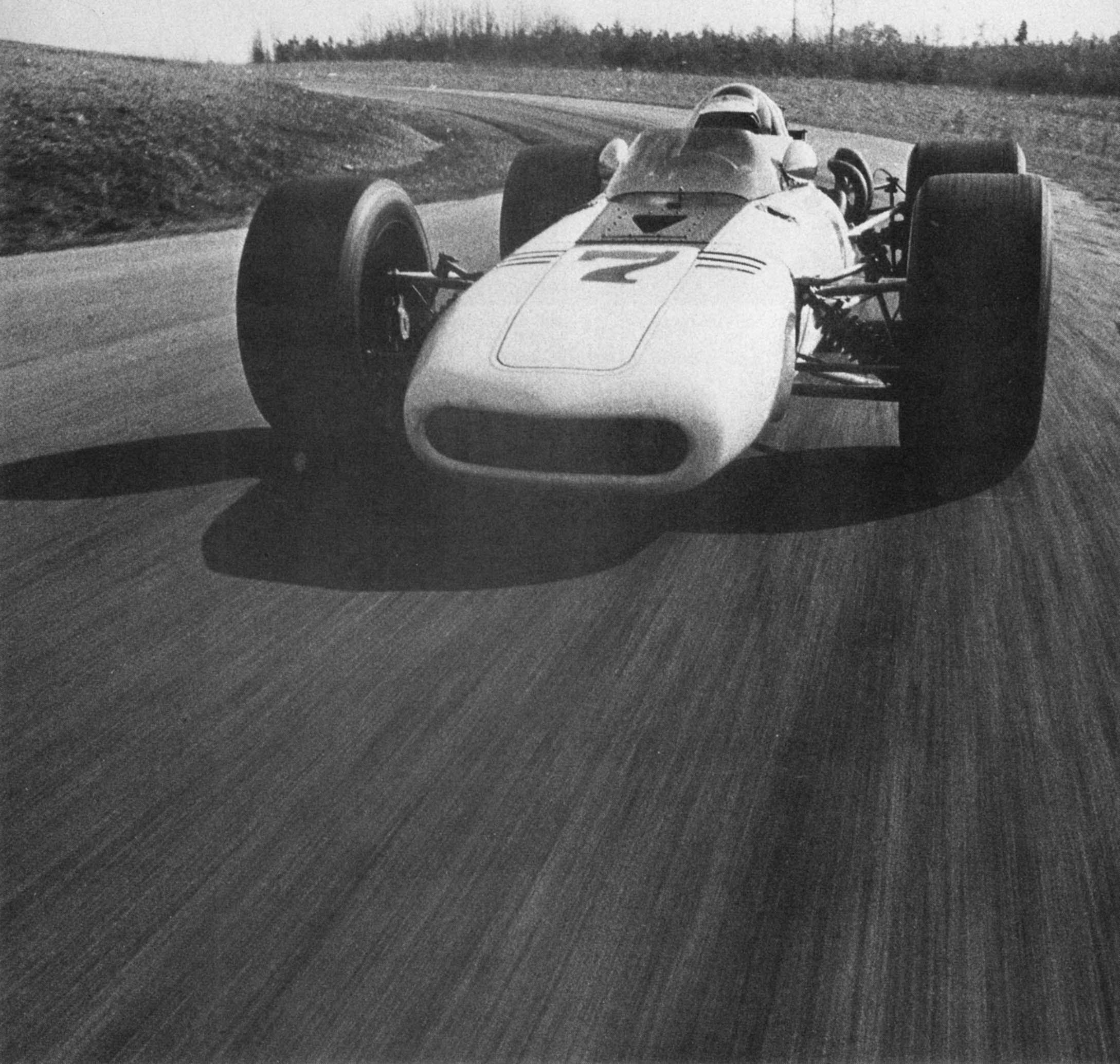
Humphrey Sutton photo
April 20, 1969
Riverside Continental Grand Prix
Riverside International Raceway
Riverside, California
Grid: 4th
Result: 3rd

Adamowicz collection – Competition Press and Autoweek
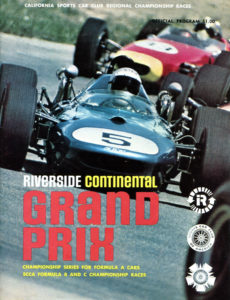

My first race ever in an open wheel machine, 460 HP TRACO Chevy and all. This was entering turn 7 at Riverside. I was leading Lothar Motchenbacher in a McLaren Chevy. I relinquished the lead in turn nine. I was hurting so badly from bruised ribs after a test crash at Willow Springs less than one week earlier, that I had to be helped in and out of the vehicle. I thought third was better than nothing the first race. John Cannon won the race.

Adamowicz collection – Ed Ingalls photo
Tony in his brand new 1969 Eagle at Riverside – on the way to winning the 1969 Formula 5000 Championship. Dan Gurney, the constructor, would later praise Tony as “The winningest Eagle driver ever.”
In the garage at Riverside

Adamowicz collection – David Nadig photo

Adamowicz collection
Tony and Dan Gurney share a laugh in the garage
Tony receiving advice from Dan

Adamowicz collection

Adamowicz collection
Tony and Dan discussing wing angle
Tony bends the Eagle into Riverside’s Turn #7

Adamowicz collection – David Nadig photo

Adamowicz collection – Gil Munz photo
Idling towards the garage area at Riverside Raceway
Riverside Turn 9, Tony drives inside Dick Simon’s Lola

Adamowicz collection – Cam Warren photo
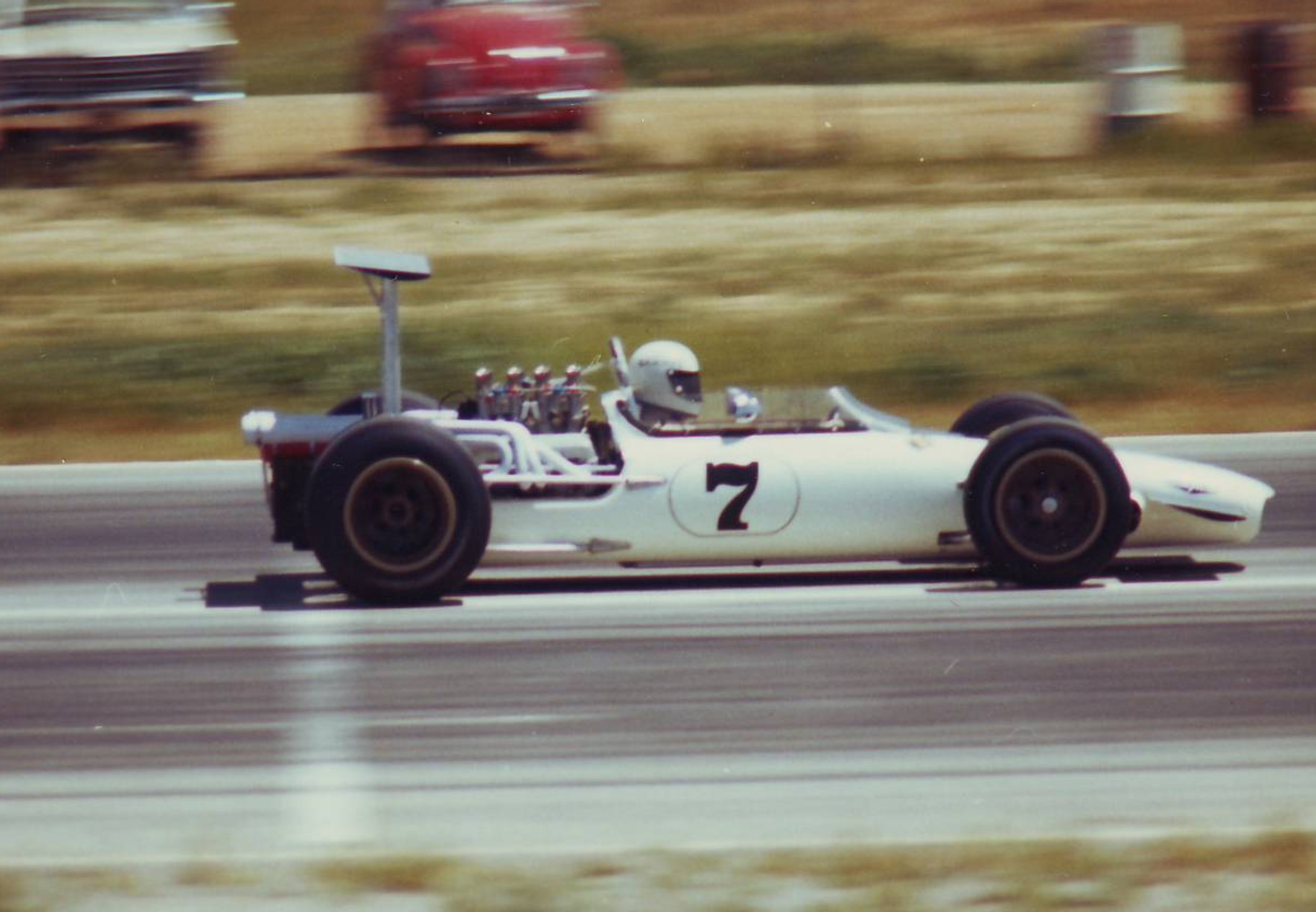
Adamowicz collection – Gil Munz photo
Tony at speed in the Eagle/Chevy, 1969 Riverside Raceway


Adamowicz collection – David Nadig photo

Competition Press coverage of 1969 Riverside Continental race (Adamowicz collection)

Adamowicz collection – Competition Press and Autoweek
May 4, 1969
Laguna Seca Royal 76 Continental
Laguna Seca Raceway
Salinas, California
Grid: 7th
Result: 16th
Tony ran off the course after 29 laps in this race and was a DNF.
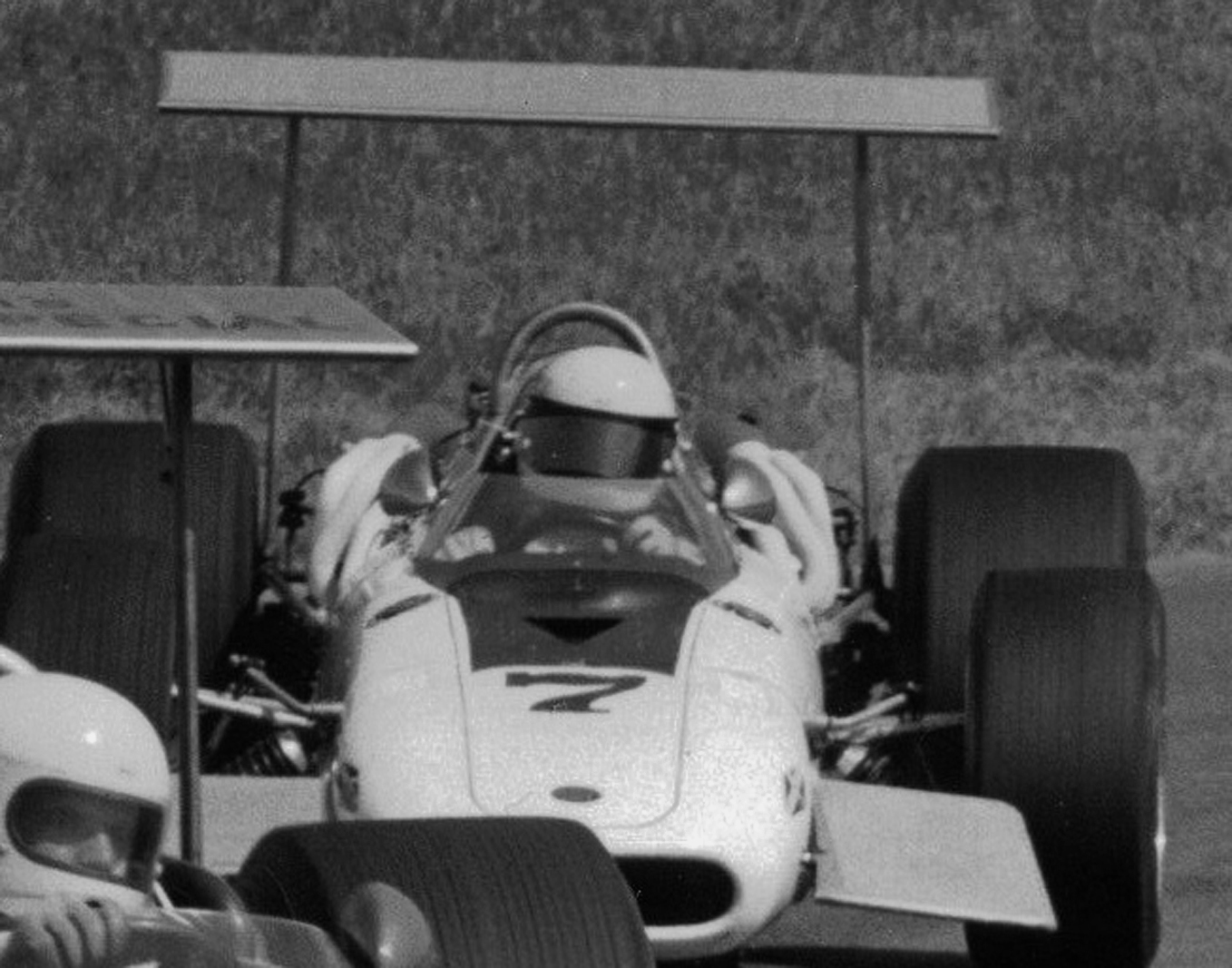
Adamowicz collection

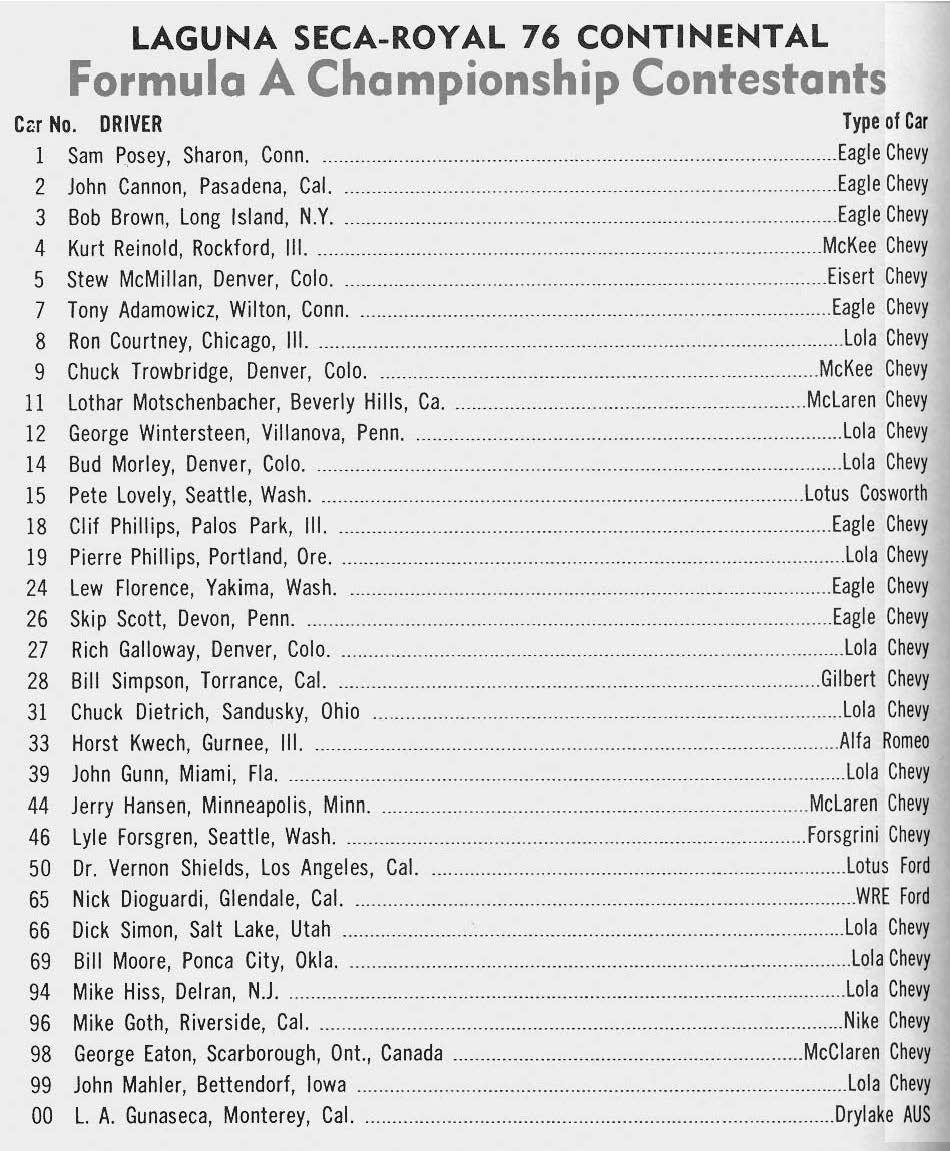

Adamowicz collection

Adamowicz collection
Adamowicz collection – Barry Tenin photo

Adamowicz collection

Adamowicz collection
June 8, 1969
Denver Post Continental Championship
Continental Divide Raceway
Castle Rock, Colorado
Grid: 2nd
Result: 11th
“Adamowicz and Posey were still fighting it out with the latter losing second on the 23rd and 24th laps. On the 27th, Adamowicz spun in turn two and picked up a rock in his engine, ending his hard effort for a win.”
By race three, Milestone racing owner Marvin Davidson had made an arrangement to hire Carroll Smith, team manager for Carroll Shelby racing. Carroll was a racer himself in the early days and a navy inducted engineer as well. Carroll was the team manger when Ford won at Le Mans in 1967. Without the guidance, mentoring and team managing of our FA5000 team, I would never have won the series. Carroll was my mentor and urged me on even when I was unsure of my abilities competing with new challenging circuits. Carroll was also a good friend with Peter Revson and held that over me that if I couldn’t get the job done, he could get “Revvie” to take the seat. I must say, Carroll Smith was a great motivator.


Adamowicz collection – Competition Press and Autoweek

Adamowicz collection – Competition Press and Autoweek

Competition Press (Adamowicz collection)
Competition Press (Adamowicz collection)
June 22, 1969
Continental ’49er
Sears Point Raceway
Sonoma, California
Grid: 6th
Result: 16th
I called it the Race of the Tow Trucks, the only race that included several tow trucks navigating the course while the race was in process. Talk about dodging big iron, it was overkill by Sears Point officials.



Competition Press (Adamowicz collection)

Adamowicz collection – Antoni Cortes photo
Adamowicz collection
Sam Posey, Pete Lovely, and Tony Adamowicz
Adamowicz collection – Competition Press and Autoweek

Adamowicz collection – Competition Press and Autoweek
July 6, 1969
Seattle International Raceway Continental
Seattle International Raceway
Kent, Washington
Result: 1st
We pulled off a glorious win at Kent, partly because of the hospitality of a local Lincoln-Mercury dealership in Belleview, WA owned by the Evered family who let us use their shop. We just managed to get a new engine from TRACO and really needed the facilities.
35 years later, I discovered Mike Evered still had a photo of the Eagle on his office wall.



Adamowicz collection – Wolfgang Klopfer photo
Adamowicz collection – Jeff Burk photo
Tony and Sam Posey chat as they walk away from the Eagle at Seattle International Raceway. Carroll Smith is behind the wing.
Adamowicz collection – Ronald Miller photo

Adamowicz collection – Ronald Miller photo

Adamowicz collection – Ronald Miller photo

Adamowicz collection – Ronald Miller photo
Adamowicz collection – Ronald Miller photo

Adamowicz collection – Pete Luongo photo


July 20, 1969
Road America “500” Championship
Road America
Elkhart Lake, Wisconsin
Grid: 6th
Result: 1st
I had the opportunity to beat the best, Englishman Peter Gethin, in the McLaren, at Elkhart Lake, Wisconsin. Our Chevy engines were very consistent, being built by TRACO Engineering. We ran Weber carbs. Our horsepower was not as great as some of the fuel injection engines used by John Cannon, Sam Posey, Lothar Motschenbacher, Gethin, etc. I had wished so many times during the season to have more power and throttle response. We did have the reliability.
Neil Armstrong and Buzz Aldrin landed the Apollo Lunar Module Eagle on the moon on July 20, 1969, the same day as this race. For Tony, the USA’s historical lunar landing and his team’s victory at Road America on the same day was very special.

Adamowicz collection – Competition Press and Autoweek
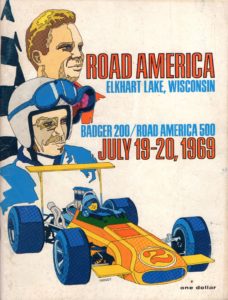


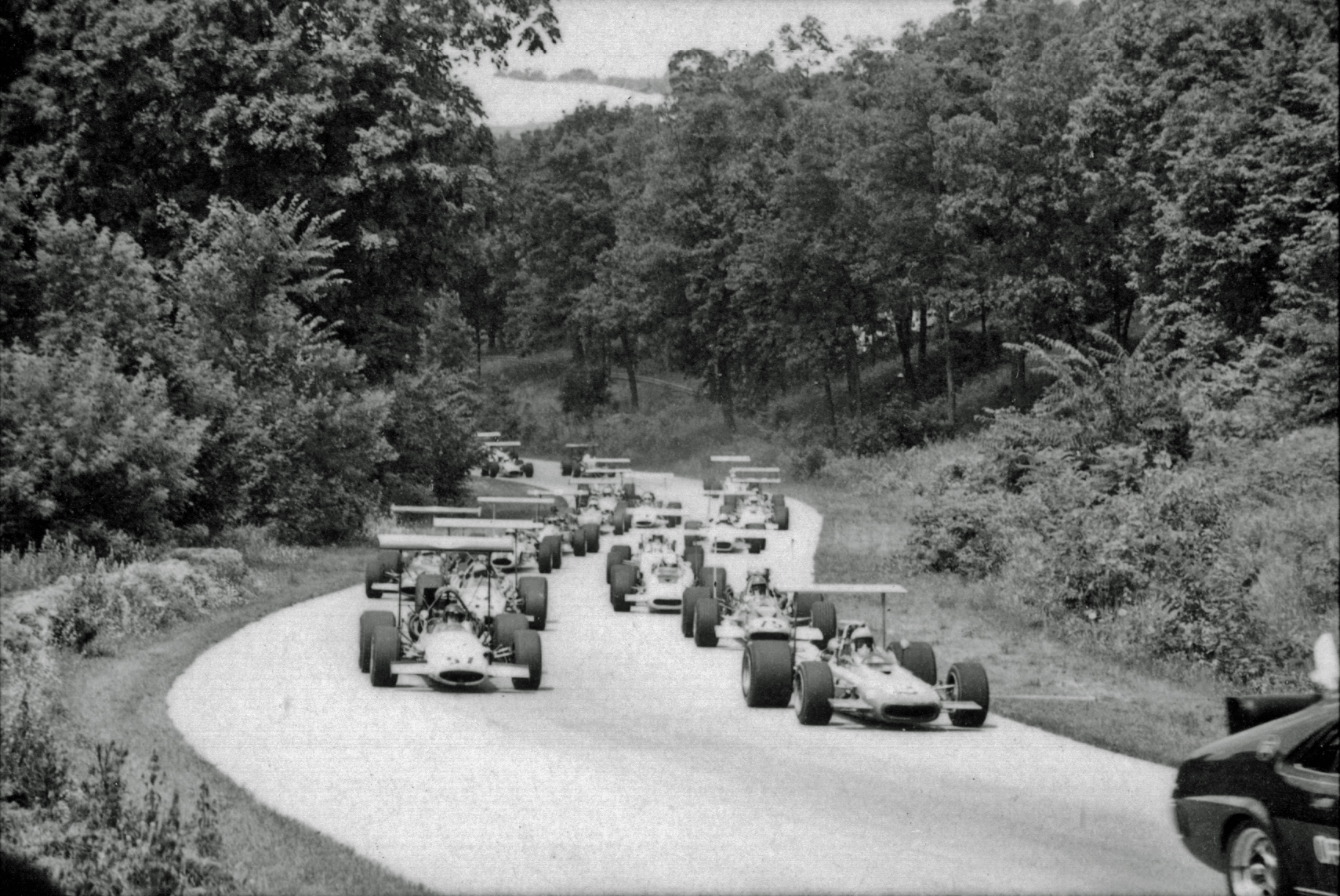
Adamowicz collection – Pete Luongo photo
The pace lap at Road America
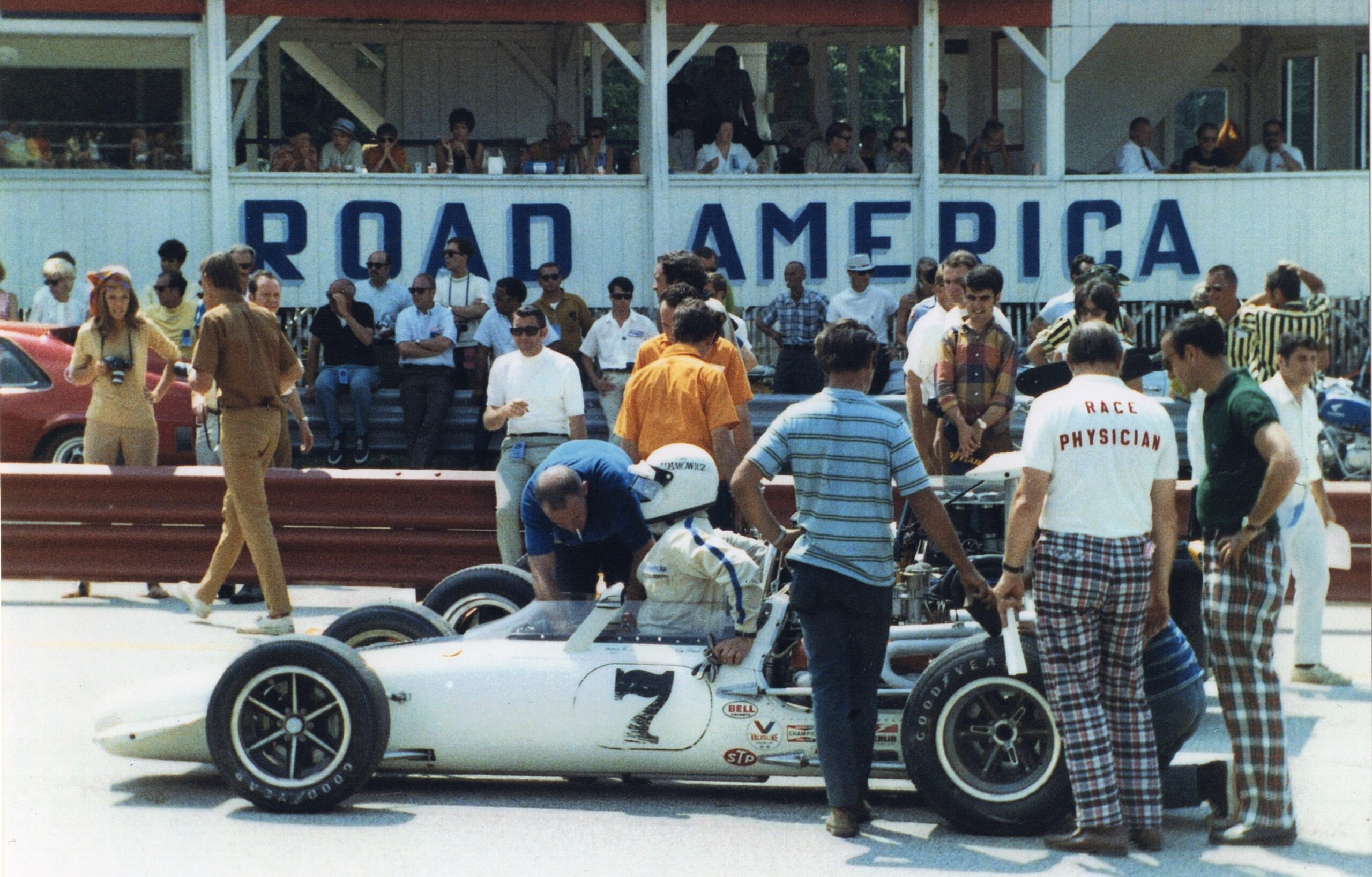
Adamowicz collection – Mark Chiles photo
Adamowicz collection – Jim Scott photo
Adamowicz collection – Competition Press and Autoweek

Adamowicz collection

Adamowicz collection – Competition Press and Autoweek


Adamowicz collection – Competition Press and Autoweek



Adamowicz collection – photo courtesy of Paul Zimmerman and Larry Fulhorst


A True Story, believe it or not!
I was coming around the turn under the bridge when I saw John Cannon’s Eagle resting in the trees ahead of me. How John got there, I don’t know, but he was not in the cockpit. The Eagle must have been 30 feet from the ground. Before the practice session was over, his car was in the garage where Bob Skinner and Tom Jobe, John’s trusty surfer mechanics, had the car dismantled and were busy repairing the outer skin. The car actually made the race. I asked John how he got out of the car that far up in the trees, his answer “Ever heard of a parachute?”
Seriously, he had to climb through the branches and finally jump to the ground. Sure wish I had a shot of his Eagle high up in the trees, the stunning view will always remain burnished in my brain.
At first Carroll Smith (with Tony in photo) didn’t believe me, and just replied that we would win the race. He was right. We did win that day at Elkhart Lake. Besides the usual competitors, the works McLaren F5000 car and their F1 driver Peter Gethin was also there.

Adamowicz collection – Pete Lyons photo (petelyons.com)
August 2, 1969
Lime Rock Schaefer Grand Prix
Lime Rock, Connecticut
Result: 5th

Tony confers with team manager Carroll Smith as Roy Wade looks on.

Adamowicz collection – David Nadig photo
Adamowicz collection



Adamowicz collection – Robert Porcelli photo
Tony, Marv Davidson, and Carroll Smith
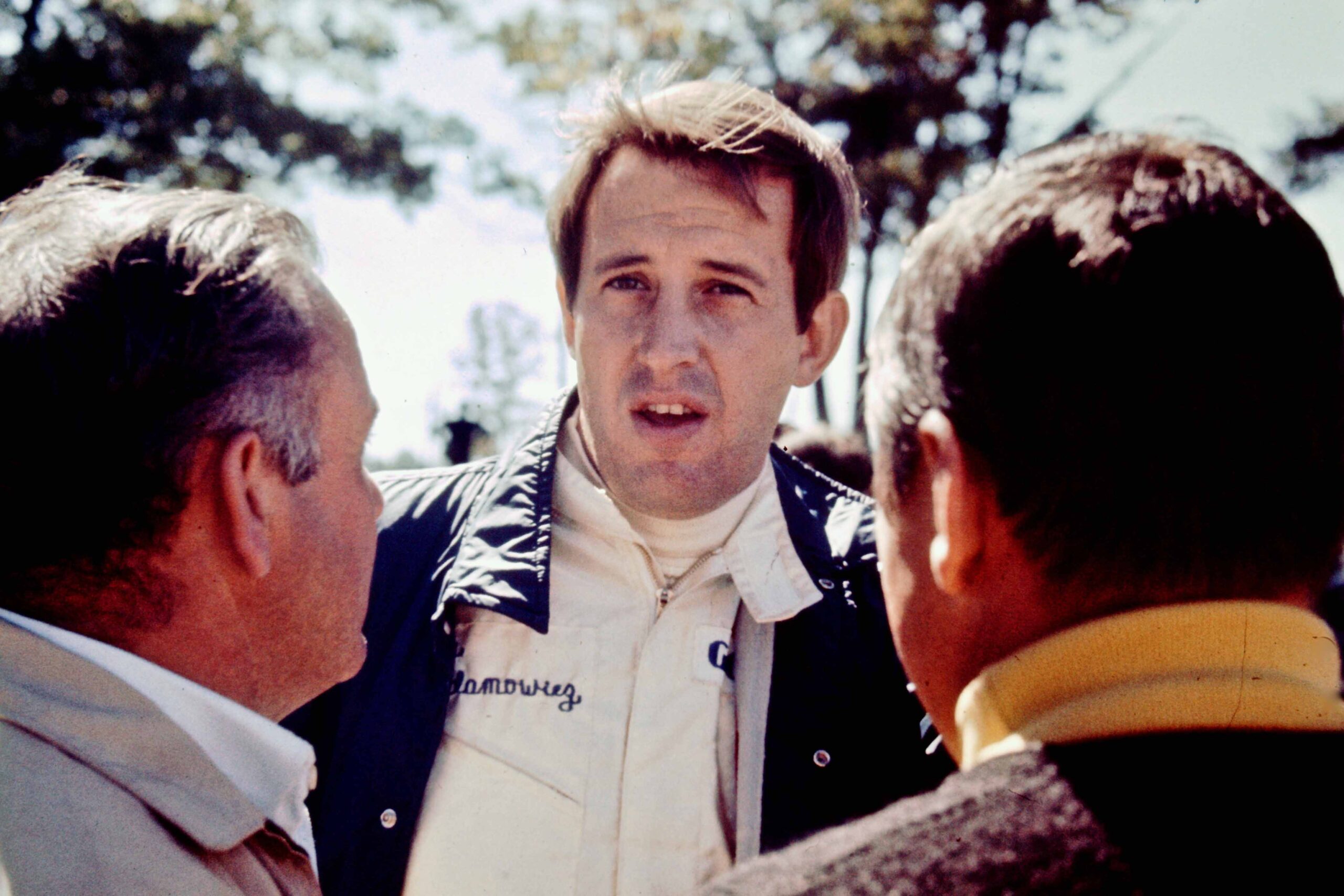
Adamowicz collection – Robert Porcelli photo
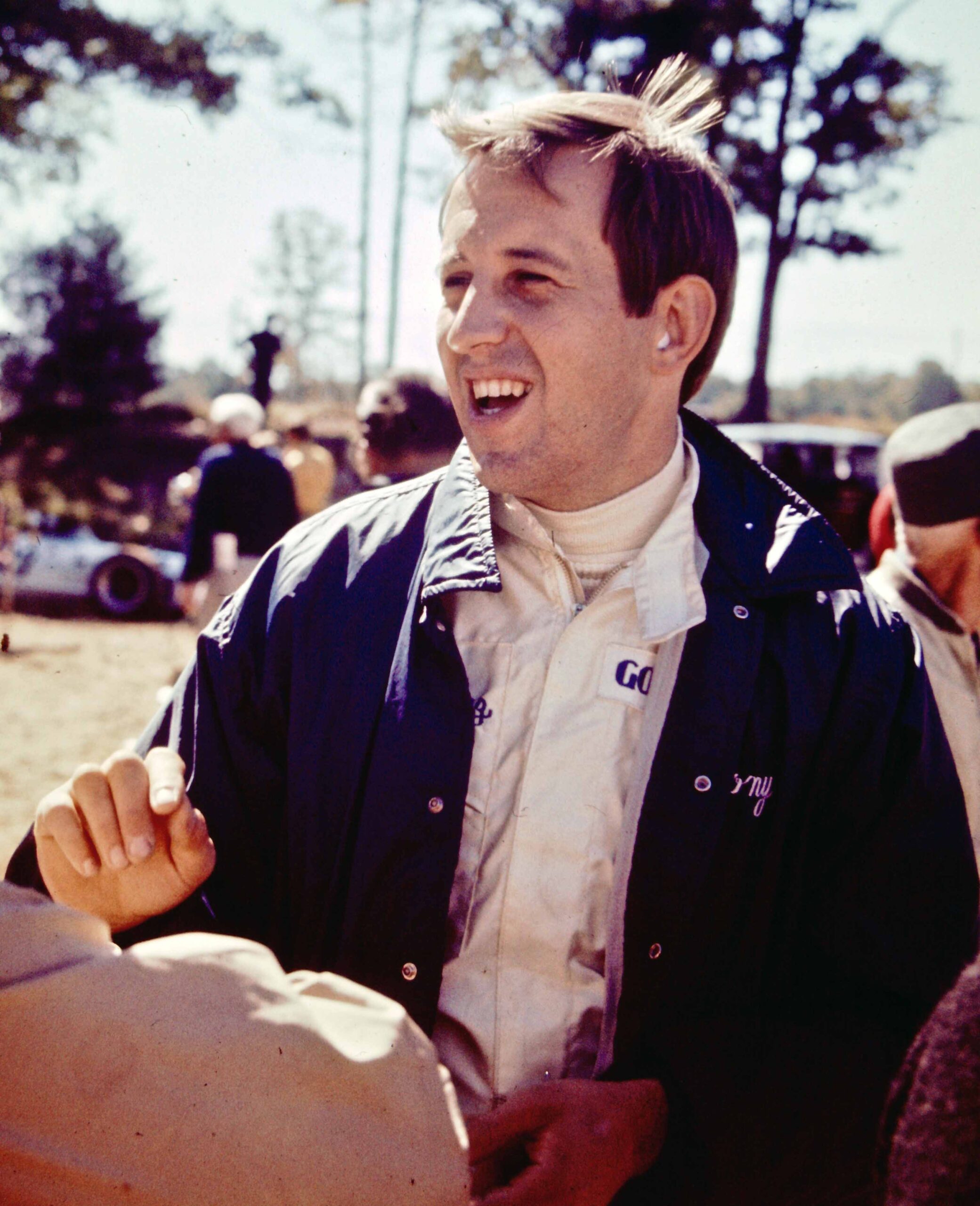
Adamowicz collection – Robert Porcelli photo
August 10, 1969
Donnybrooke Raceway Continental
Brainerd, Minnesota
Grid: 5th
Result: 2nd

Adamowicz collection – Competition Press and Autoweek


Adamowicz collection – Pete Lyons photo (petelyons.com)

Adamowicz collection – Bill Oursler photo

Adamowicz collection – John Radosta photo
Competition Press & Autoweek


Adamowicz collection – Competition Press and Autoweek
August 23, 1969
Mosport Continental Sundown Grand Prix
Bowmanville, Ontario Canada
Grid: 7th
Result: 2nd

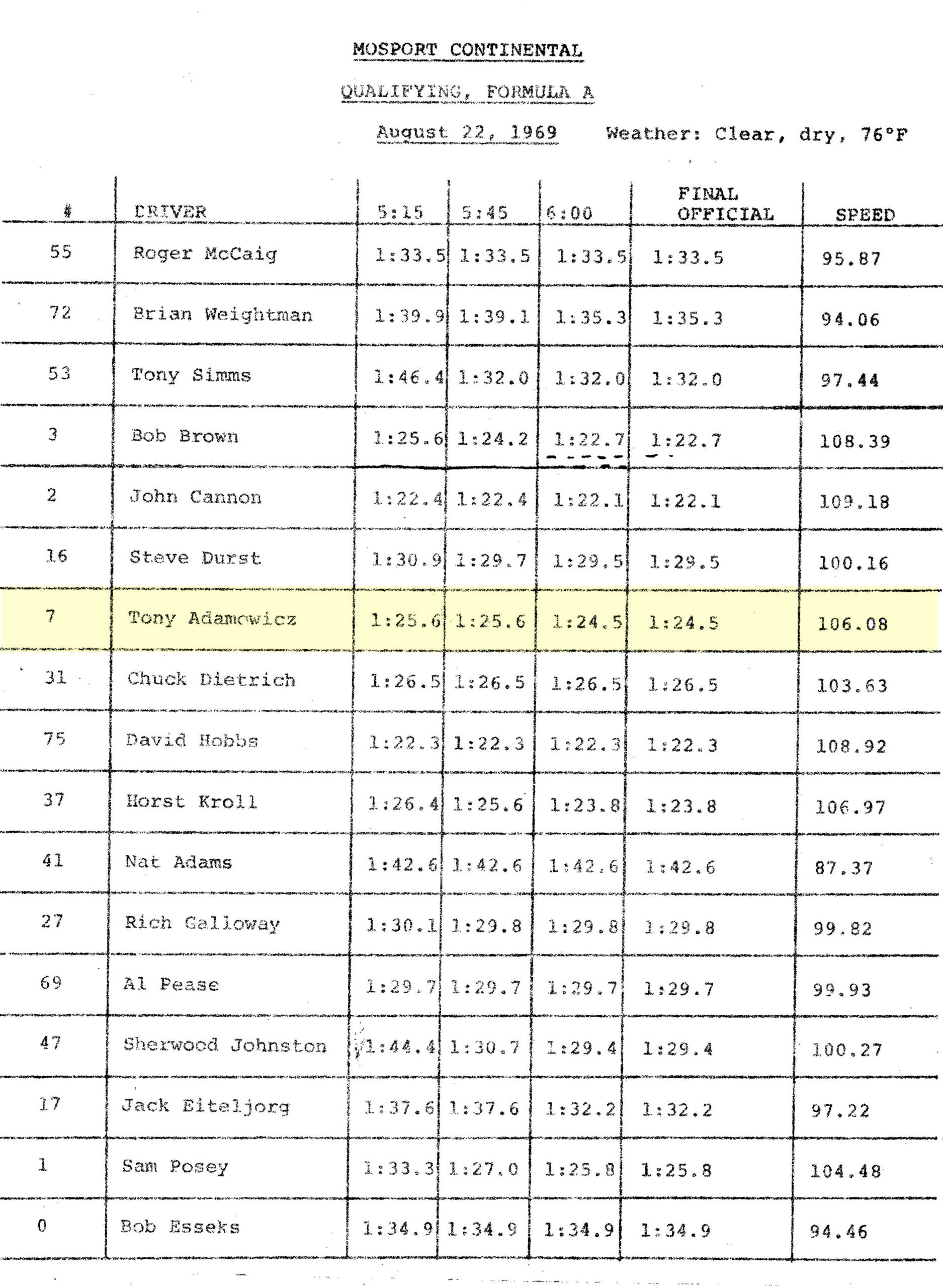


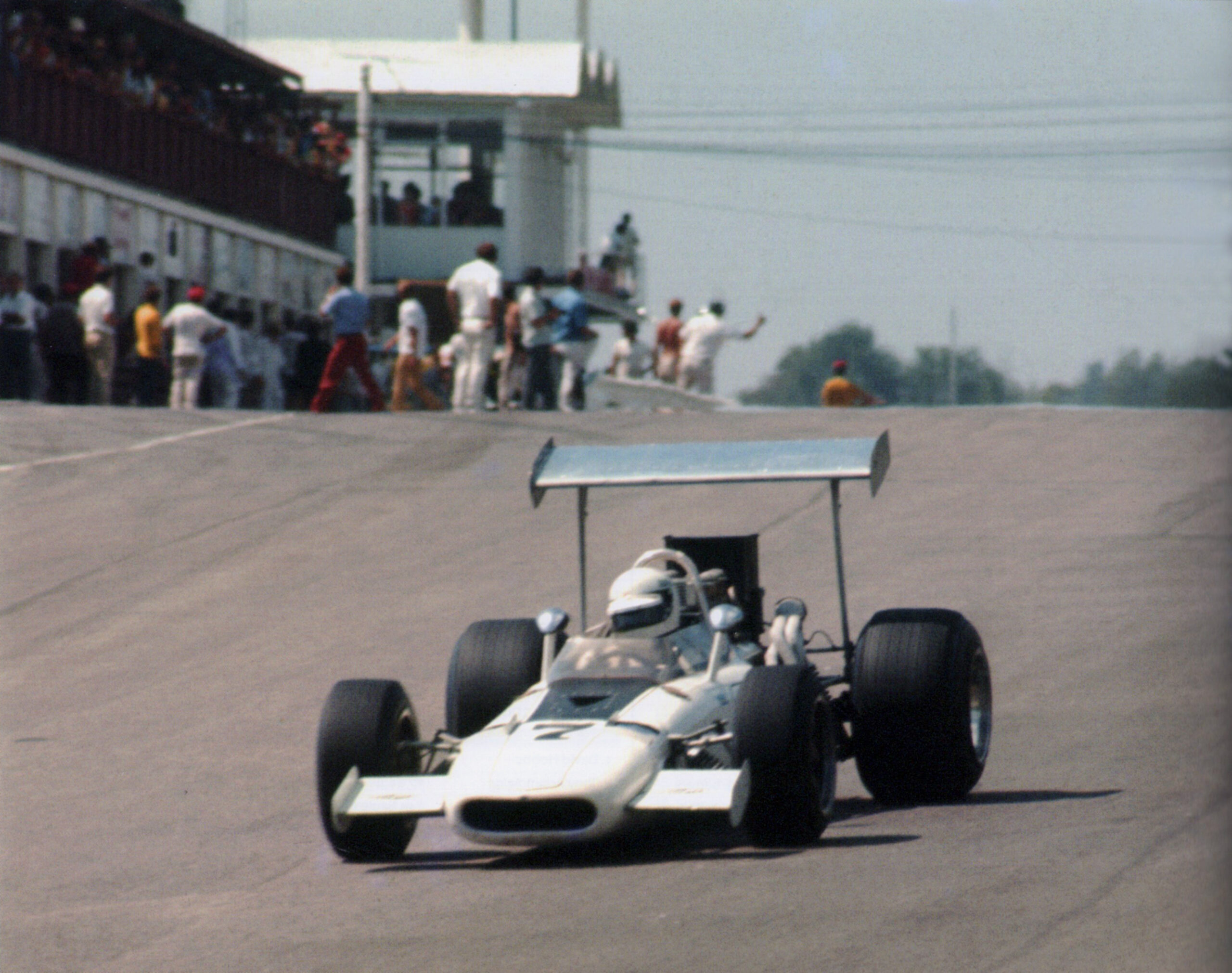
Adamowicz collection – Barry Tenin photo

September 1, 1969
Lime Rock English Leather Grand Prix
Lime Rock, Connecticut
Grid: 7th
Result: 4th
Local driver wins Lime Rock Continental championship race
9/1/69: Lime Rock, Connecticut, by Joseph Cali
Sam Posey of near-by Sharon, Connecticut won todays English Leather Grand Prix for Formula SCCA. Formula A class cars at Lime Rock Park in Lime Rock, Connecticut in his Steve Allen sponsored McLaren- Chevy. Posey, who qualified for the pole position on the starting grid with a new lap record of 51.4 seconds for the twisty 1.6 mile road course took the lead at the start, but he was passed going up the hill on the back straight, just before the “Climbing turn” by Andrea de Adamich of Milano, Italy driving a Surtees TS5 Chevy.
de Adamich held the lead until the 46th lap of the 70 lap race but lost it to Posey when his Bartz-prepared Chevy engine started to lose power. Posey held the lead for the remainder of the race, but was pushed very hard in the last 10 laps by George Wintersteen of Villanova, Pennsylvania in an Eagle-Chevy, and by de Adamich’s team-mate David Hobbs of London, England in another Surtees-Chevy.
For his win Posey collected $6,500 plus 9 points toward the championship and a gallon of English Leather cologne. He also won a case of Inver House scotch for the fastest qualifying time.




Believe it or not, no damage was done with the “over-exuberant” driving style at Lime Rock.

Adamowicz collection – Pete Luongo photo

September 7, 1969
Circuit Mont-Tremblant St. Jovite Continental
Mont-Tremblant, Quebec, Canada
Grid: 3rd
Result: 3rd


Adamowicz collection – Maron Films Ltd.
Screen shot during race weekend from James Garner’s The Racing Scene, where portions of the film were shot.

Competition Press and Autoweek article

Adamowicz collection


Adamowicz collection – Competition Press and Autoweek

Adamowicz collection

Adamowicz collection – Competition Press and Autoweek
September 21, 1969
Thompson Speedway Continental
Thompson, Connecticut
Grid; 6th
Result; 3rd


Adamowicz collection
Pace lap
Tony leads Andrea de Amich through a turn

Adamowicz collection

Adamowicz collection – Competition Press and Autoweek


Adamowicz collection – Competition Press and Autoweek


Adamowicz collection – Competition Press and Autoweek

November 20 and 27, 1969
Willow Springs (11-20-69) and Riverside (11-27-69)
Testing of the Boss 302 engine
It was quite an installation of the Ford engine. We had to carve away some of the inner tub for clearance. The engine still sat with a higher center of gravity than the Chevy and affected the handling somewhat. The sound of the air intakes were awesome, listening from the cockpit. The 4 exhaust headers were almost a 180-degree exhaust system. A large oil cooler behind the air intake was added for additional cooling. No real thought was given to streamlining back then.
The wing was a modified airfoil shape taken from a drag race design. The original wing from the AAR shop had a much thinner airfoil. Also note we had knock-off hubs at the rear, after exhausting F/A hub parts supply from Gurney. The original design was not as beefy as the champ car hubs, and cracked where the machined radius was too sharp.
We never had any further problems with the knock offs, although at the end of the season, both John Cannon and Bobby Brown crashed/broke standard hubs at Thompson race in the banking. Despite all our early warnings to Gurney’s shop and other Eagle drivers, no one took heed.


Adamowicz collection – Sport Auto publications
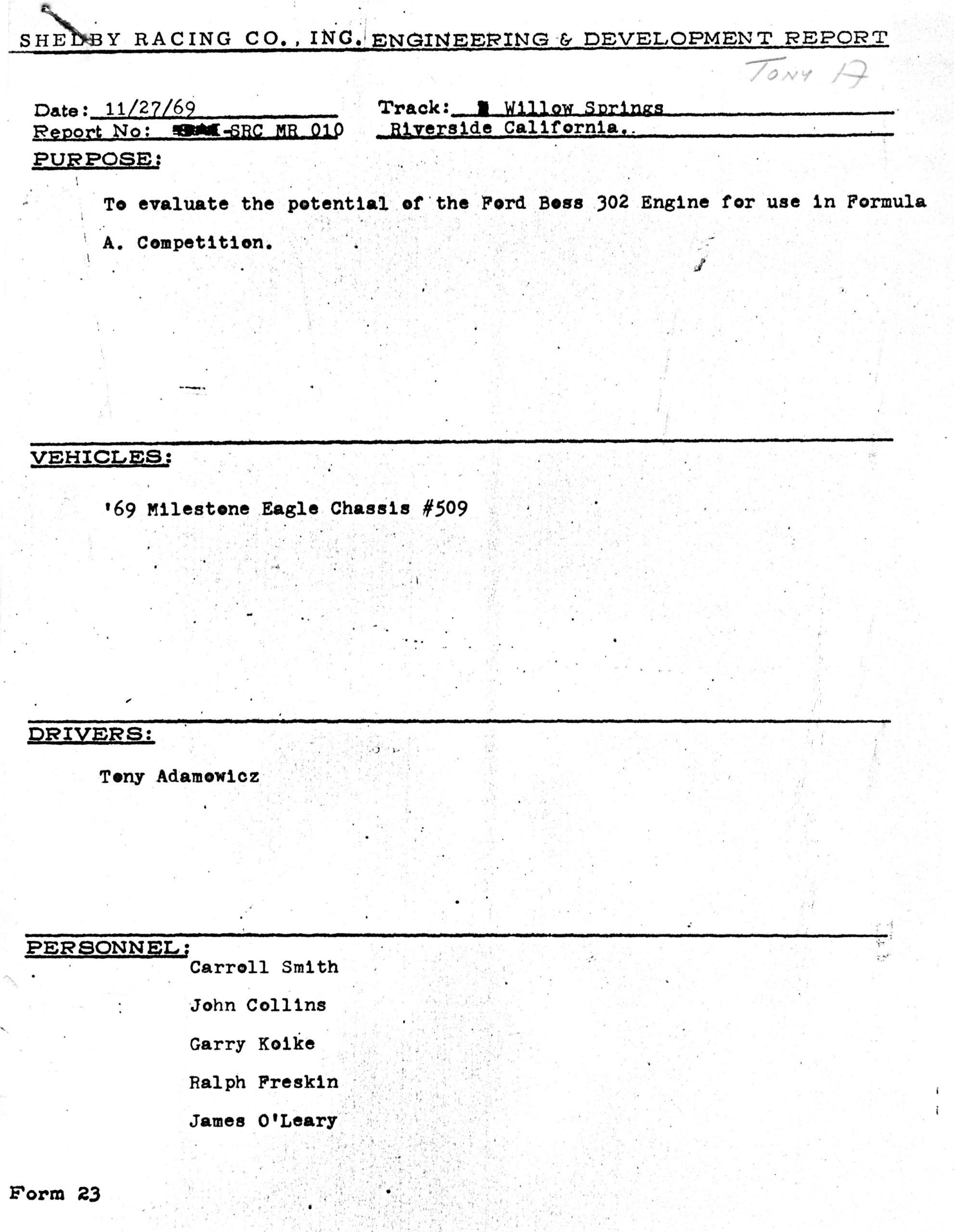

Here’s a rare photo of a testing session at Riverside with newly installed Ford engine in preparation for the last race at Sebring. Note the reinforced radius arm mounts to the tub.

Adamowicz collection – Pete Luongo photo
December 28, 1969
L & M Grand Prix
Sebring International Raceway
Sebring, Florida
Result: 22nd
The last race was at Sebring, Florida, in December. Mario Andretti had the latest Lotus chassis, and I had my old battle-scarred Eagle converted to the Ford 302. I was able to run with modified Bosch fuel injection, Mario had the light-weight Weber carbs on the Lotus. We were the only two that had Ford engines. We had hoped to do well with these engines to run the following season with Ford power. The Ford produced more power than the Chevy and had better throttle response with fuel injection.
The conversion did not help the Eagle`s handling, as the Ford engine design does not carry the lower center of gravity as the Chevy. Although we had more power, we lost some of our handling capability. Both engines lost bottom ends, mine blowing on the pit straight in front of everyone there.
The last race we were able to use the Indy upright along with smaller version of the Lockheed Can-Am caliper. That helped a great deal. The Eagle chassis was very reliable, heavier built than any of the newer European competitors that came along later in the season. My Championship was won through consistency.



Adamowicz collection

Adamowicz collection – Harry Hurst photo

Adamowicz collection – Jabbie Cronbeck photo, Sport Auto publications
Sebring airport 69 Formula A/5000 finale. Despite Ford engine losing it’s bottom end, we won the championship.
|
The Ford engine installation at Sebring |

Adamowicz collection – Harry Hurst photo

Adamowicz collection – Harry Hurst photo
Tony’s Eagle at the 1969 Sebring race
|
Tony talks with Leon Mandel, journalist with Autoweek and Car & Driver. |

Adamowicz collection – Phil Allen photo

Adamowicz collection – Harry Hurst photo
A great shot of Tony passing Jerry Hansen
Tony a2z and Sam Posey grin happily – beneath the Sebring Airport tower.

Adamowicz collection – Bernard Cahier photo
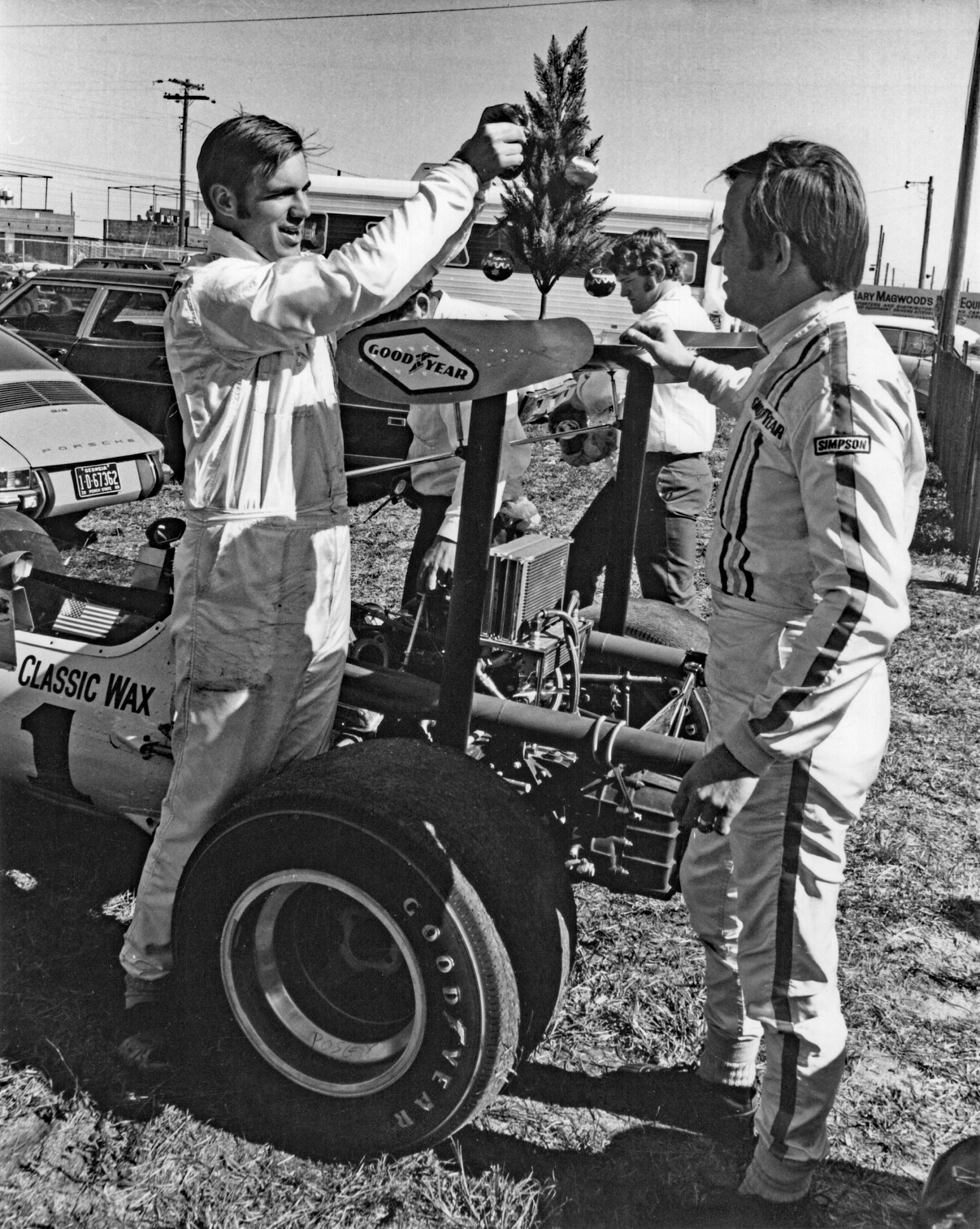
Adamowicz collection
Sam Posey and Tony clowning around with Christmas tree on Sam’s wing at Sebring.
Tony climbs out of Eagle after engine failure

Adamowicz collection – Pete Lyons photo (peteyons.com)

Adamowicz collection – Road & Track photo
Oil pooled under the Eagle at Sebring

Tony’s first place trophy was seriously damaged at a house fire at his parent’s house. He managed to salvage the trophy plaque shown here.

Adamowicz collection – Competition Press and Autoweek
The 1969 Eagle Formula A of Dan Gurney`s All American Racers company was probably the very best constructed chassis for the time. As the Championship series continued, more competitive chassis started to appear towards the end. McLaren, Surtees, Lola. The weight , brakes and suspension geometry improved tremendously. With regards to handling, the chassis had limited suspension travel and was not as competitive as the McLaren or Surtees with updated Formula One improvements. It liked the smoother tracks. The brakes were never really good with the standard spindle upright provided. The spindle flexed, kicked back the pads and consistently had inadequate brake application. I was the only driver in the series using left foot braking with a special pedal setup, to make sure I always had a brake pedal going into the turns.
Photo gallery

Adamowicz collection
Tony poses for photos before a race.

Adamowicz collection

Adamowicz collection

Adamowicz collection – Barry Tenin photo
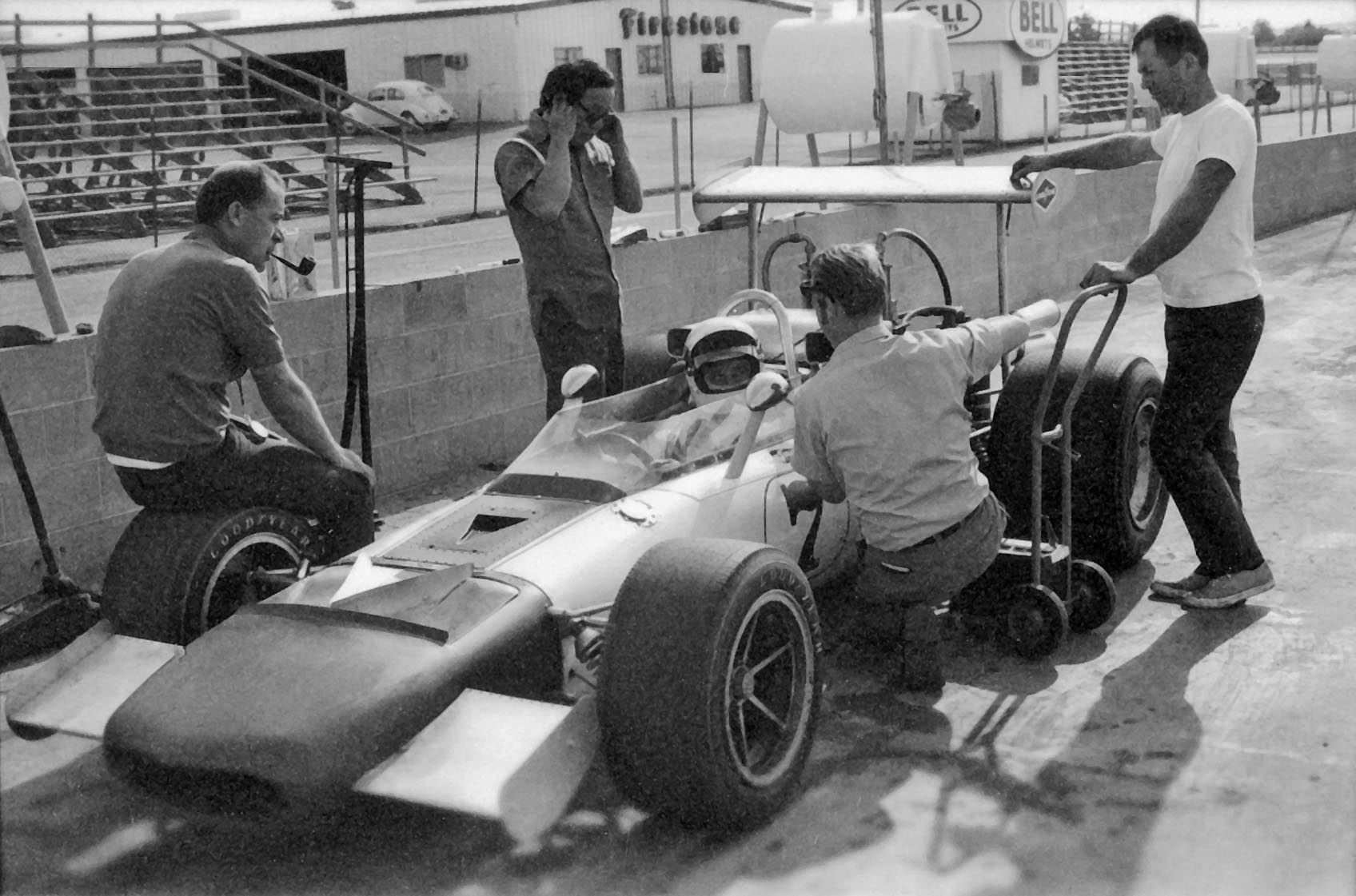
Adamowicz collection

Adamowicz collection

Adamowicz collection

Adamowicz collection
Congratulatory telegram sent to Tony from All American Racers


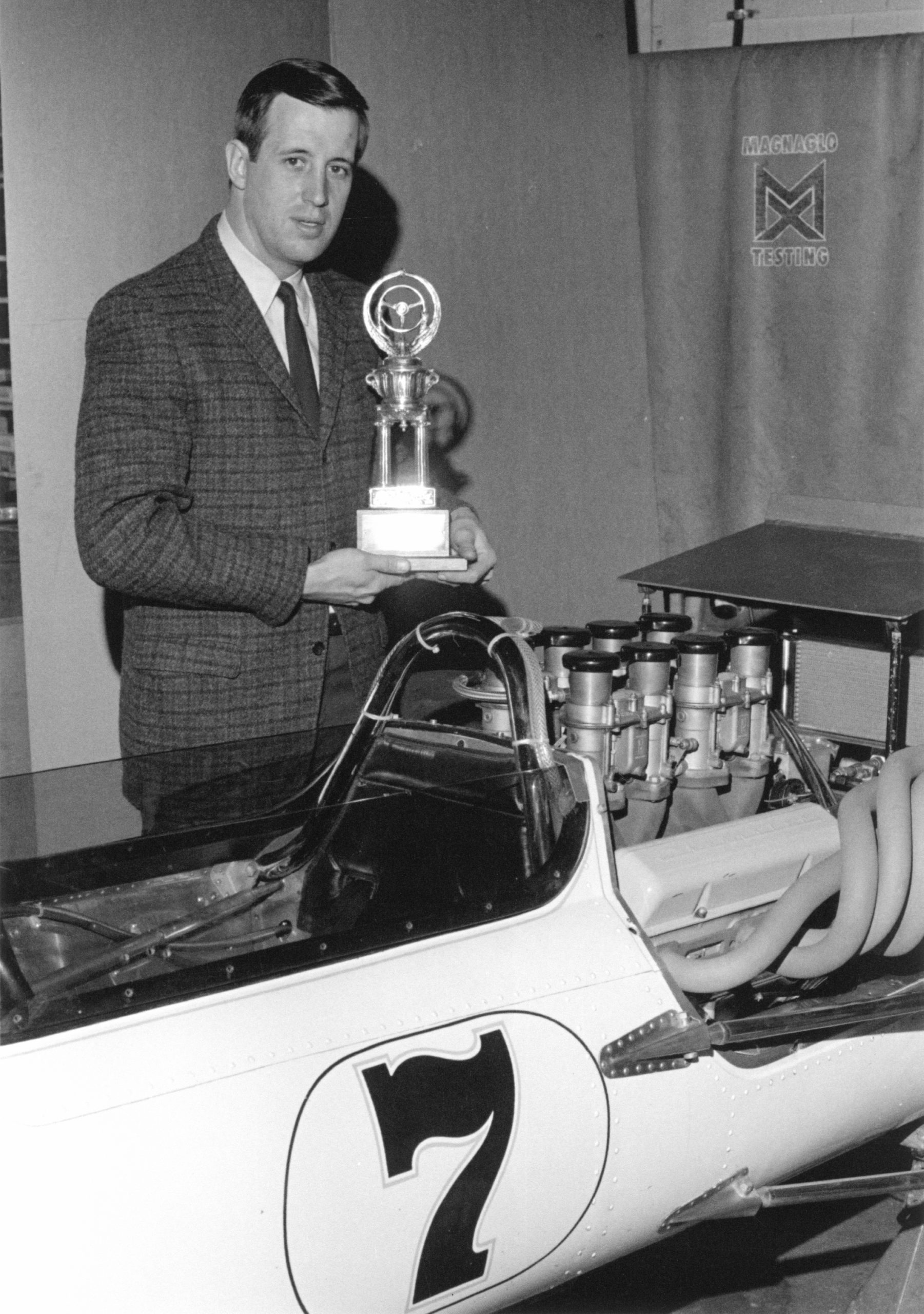
Adamowicz collection




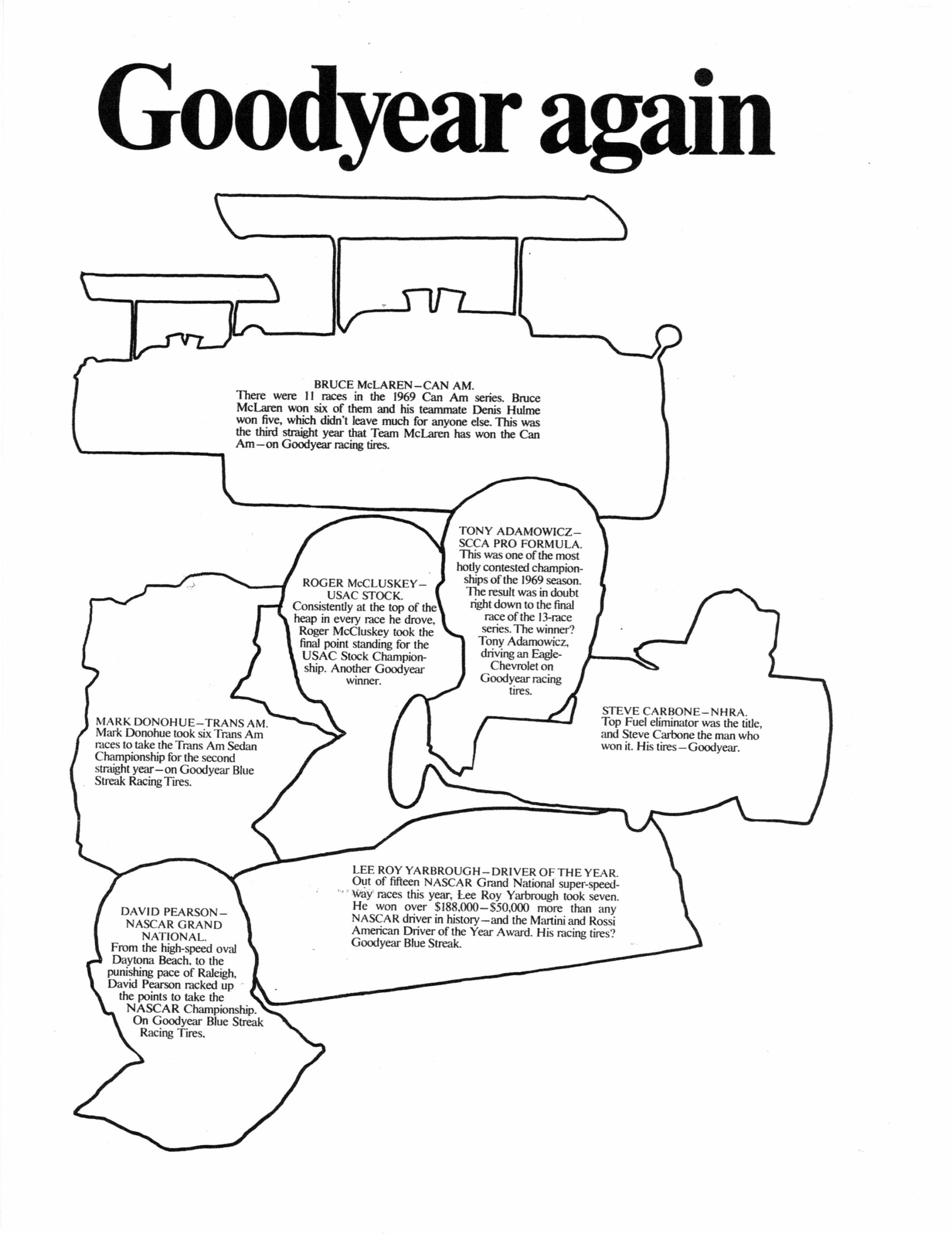

Competition Press advertisement for Chassis #s 510 and 502
My Initiation to open wheel formula 5000 racing, the 1969 Continental Championship
By Tony “a2z” Adamowicz
Straight from winning the 1968 Under 2 liter Trans Am Championship for Porsche, where we dominated this pro series, my car owner of Milestone Racing, Marvin Davidson asked me what I wanted to race the following year. With out hesitation I indicated to him, the Formula A/5000 series with a Gurney Eagle Mk. 5.
What I didn’t know was how things were to work out, and actually I was to bite off more than I could chew. You see I had never driven an open wheel car, let alone a 1400 lb, 5 liter Chevy stock block with then 480 available hp. My intro to my desires would unravel quickly as I was asked to drive the car at VIR (Virginia International Raceway) for Car & Driver magazine. Leon Mandel had arranged to have Sam Posey’s Can Am car there and it was to be a comparison between the cars. When I arrived at VIR, the Can Am car had already been destroyed. I was faced with the daunting task of fulfilling my job to drive Eagle for the test.
My First time in the car was with sub zero weather with running ice water across various parts of the track; my eyes became as big as saucers. I was able to make through this test unscathed and immediately related to my car owner, that we needed to get some real seat time in sunny California. He agreed and my former Group 44 Mechanic Roy Wade and helper Don Bresslauer and I proceed to drive to Ca. arriving at our destination, Willow Springs Raceway, located in the desert of Rosamand, Ca. We unloaded the Eagle and proceeded to get some valuable seat time at this unknown raceway.
Little did I know that the winds came up around 3 o’clock in the afternoon and provided some interesting consequences for me? Our Eagle had no wing down force at the time, as I was entering turn 6 , a fast right-hand , blind , reverse camber turn a gust of wind helped my Eagle to become airborne and promptly take flight, level off and ultimately plummeting into the desert floor outside the track. It continued to become airborne again and repeated the second stage of my previous uncharted fight plan. My open faced “Jim Clark inspired” helmet with goggles did little to protect me from a serious cut above my eyebrow, more over I had some serious pain in my ribs. A quick jaunt to the local hospital revealed I was very lucky not to have any broken bones, small consequence to our totaled Eagle.
Fortunately we had a brand new Gurney Eagle being completed at the All American Racers factory in Santa Ana, Ca. It was not yet completed and it was less than 2 weeks before the first race at Riverside International Raceway. The crew proceeded to strip down the wrecked Eagle to save any useful parts for spares. John Cannon had been testing our new wings and larger rear wheels at Riverside Raceway and was doing quite well with the new pieces. Finally our new car was completed by AAR and we arrived at RIR ready for practice. My bruised dribs did not allow me to enter or get out of the cockpit by myself; I had to be helped in and lifted out the car each time. The bumps encountered over the track, provided me with excruciating pain to endure. Practice with these new FA/5000 cars provide more excitement as various cars started to crash and have their new high mounted suspension wings come apart. Sam Posey totally destroyed his new Eagle, providing a spectacular shunt and becoming airborne, complete with flames. Fortunately he was alright, however his car was destroyed, I immediately determined that these Eagles were not meant to fly…..do you think?
As the very first FA/5000 race drew underway, I was fortunate to get a good start and was running 2nd behind John Cannon in his sorted and very fast Eagle. During the course of the race I was challenged by Lothar Motchenbacher in his new McLaren and rather than risk going off track, I motioned for Lothar to pass me going into the famed turn 9 oval. The bruised ribs provided enough pain to allow this to take place. We finished the 40 minute race in 3rd place, hmmm not bad for a rookie.
The following races provided more entertainment as we encountered several failures with chassis components. It was becoming acutely aware that we were way in over our head in chassis preparation my lack of Formula 5000 driving experience. It was then that my car owner had made a deal with Carroll Shelby to hire his team manager and engineer, Carroll Smith. Carroll had been with Shelby as team manager when their Ford Mk 4 won the 24 hours of Le Mans. We welcomed Carroll as pivot able team manager addition to our group, providing expert knowledge and application to our Eagle. Being a former formula driver in Europe himself, this allowed him to mentor me in my education of Formula 5000 racing.
We struggled through the 13 race season with two wins, one at Road America, Elkhart Lake, Wisconsin and Seattle International Raceway in Kent Washington. We racked up consistent top points by our well place finishes through out the season and we had enough points to be leading in the Championship for the final race at Sebring. We had the opportunity to drive among some great professional international drivers and teams. Thanks to our team and particularly Carroll Smith for the excellent driver mentoring and preparation of our Eagle. Without Carroll’s engineering expertise, we would have never won the Championship.



